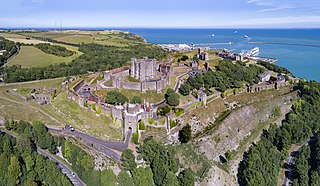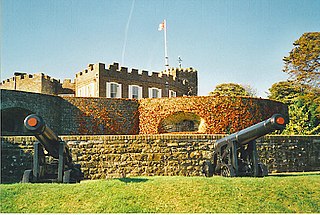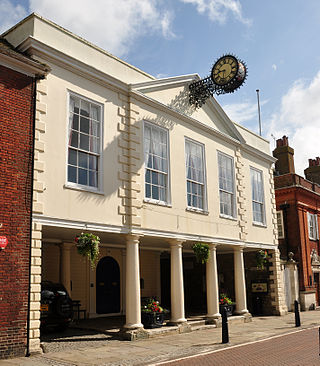
The confederation of Cinque Ports is a historic group of coastal towns in south-east England – predominantly in Kent and Sussex, with one outlier (Brightlingsea) in Essex. The name is Old French, meaning "five harbours", and alludes to the original five members. At its peak in the Late Middle Ages, the confederation included over 40 members. There are now a total of 14 members: five "head ports", two "ancient towns" and seven "limbs".

Dover Castle is a medieval castle in Dover, Kent, England and is Grade I listed. It was founded in the 11th century and has been described as the "Key to England" due to its defensive significance throughout history. Some writers say it is the largest castle in England, a title also claimed by Windsor Castle.

Walmer is a town in the district of Dover, Kent, in England. Located on the coast, the parish of Walmer is six miles (9.7 km) south-east of Sandwich, Kent. Largely residential, its coastline and castle attract many visitors. It has a population of 6,693 (2001), increasing to 8,178 at the 2011 Census.

Hythe is a market town and civil parish on the edge of Romney Marsh, in the district of Folkestone and Hythe in Kent, England. The word Hythe or Hithe is an Old English word meaning haven or landing place.

The Lord Warden of the Cinque Ports is a ceremonial official in the United Kingdom. The post dates from at least the 12th century, when the title was Keeper of the Coast, but may be older. The Lord Warden was originally in charge of the Cinque Ports, a group of five port towns on the southeast coast of England that was formed to collectively supply ships for The Crown in the absence at the time of a formal navy. Today the role is a sinecure and an honorary title, and fourteen towns belong to the Cinque Ports confederation. The title is one of the higher honours bestowed by the Sovereign; it has often been held by members of the Royal Family or prime ministers, especially those who have been influential in defending Britain at times of war.

Sir Simon de Burley, KG was holder of the offices of Lord Warden of the Cinque Ports and Constable of Dover Castle between 1384–88, and was a Knight of the Garter.
Sir Henry de Sandwich was Lord Warden of the Cinque Ports during the 13th century.
Sir Bertram de Criol was a senior and trusted Steward and diplomat to King Henry III. He served as Constable and Keeper of Dover Castle, Keeper of the Coast and of the Cinque Ports, Keeper of the receipts, expenses and wardships of the archbishopric of Canterbury, Constable of the Tower of London and Sheriff of Kent.
Sir Robert de Herle was an English military commander who was Admiral of all the Fleets about England and Lord Warden of the Cinque Ports during the mid-14th century.
Sir Ralph Sandwich (1235–1308), of Dene, Ham, and Ripple, Kent, Winchfield, Hampshire, etc., was an English administrator and justice. He was Steward of the King's Demesne, Constable of Canterbury (1278), and Royal Warden of London.
Robert de Auberville, of Iham and Iden, Sussex, representative of a wealthy Norman family in Kent and Sussex, was a Justiciar in Kent, Constable of Hastings Castle, and Keeper of the Coast to King Henry III of England.
Walter de Burgsted was an English judge and Lord Warden of the Cinque Ports during the thirteenth century.

Nicholas de Crioll, of a family seated in Kent, was Constable of Dover Castle and Keeper of the Coast during the early 1260s. His kinsman Bertram de Criol had distinguished himself in these offices during the preceding 20 years and both were near predecessors of the eminent Warden of the Cinque Ports, Stephen de Pencester.
John Philipot was an officer of arms at the College of Arms in London and a politician who sat in the House of Commons from 1628 to 1629. Though he successfully attained the position on Somerset Herald of Arms in Ordinary, he is best known for his production of a roll of arms of the Lord Wardens of the Cinque Ports.
The History of Dover, because of the town's proximity to the Continent begins when Stone Age people crossed what was then a land bridge, before the opening up of the English Channel. Since then, successive invasions of peoples have taken place. Archaeological finds have revealed a great deal, particularly about cross channel trade and the attempts of those various inhabitants to build large-scale defences against European invaders on this part of the English coast.
Until the Reform Act 1832, there were eight constituencies in the Parliament of England and its successors related to the Cinque Ports. The cinque port constituencies were slightly different from parliamentary boroughs. The 1832 Act abolished most such distinctions, and disfranchised some of the cinque ports as rotten.
The 1st Cinque Ports Artillery Volunteers was a part-time unit of the British Army's Royal Artillery from 1860 to 1956. Raised as coastal defence artillery, the unit later served as field artillery in Mesopotamia during World War I, and as anti-aircraft artillery during the Blitz and in the Middle East during World War II.
Admiral of the Fleet Sir Ralph de Spigurnell or Ralph Spigurnell, was a Medieval knight, diplomatic envoy and English naval commander who was appointed Admiral of all the Fleets of the English Navy, Warden of the Cinque Ports and Constable of Dover Castle who served under King Edward III of England from 1337 to 1373.
The Wardens of the Coast, originally called the Keepers of the Coast or Keepers of the Sea, were officials appointed in the Kingdom of England and placed under the jurisdiction of one of the regional admiralties of England, those of the North, South and West. On behalf of the King of England they were responsible for the direction and co-ordination of the King's fleet, the equipping of boats and processing payments to sailors and the superintendence of the Sea Guard Militia assigned to each coastal maritime county during the 13th, 14th and 15th centuries. The most notable of these were the Warden of the Cinque Ports (1226–1267), later called Lord Warden of the Cinque Ports and Constable of Dover Castle (1267–present), and the Wardens of the Marches (1297–1603). By the beginning of the 16th century they were replaced by the vice-admiralties of the coast.
The 1st Cinque Ports Rifle Volunteers was a part-time unit of the British Army first raised from the Cinque Ports of Kent and Sussex in 1859. It later became the 5th Battalion of the Royal Sussex Regiment. During the First World War, it served on the Western front as pioneers, seeing a great deal of action at Aubers Ridge, the Somme, Ypres, and in Italy. In the Second World War, both the battalion and its duplicate served in the Battle of France and were evacuated from Dunkirk. The 5th Battalion then fought at the Second Battle of El Alamein while its duplicate unit served as an anti-aircraft regiment in the campaign in North West Europe. Neither unit was reformed after the war.






